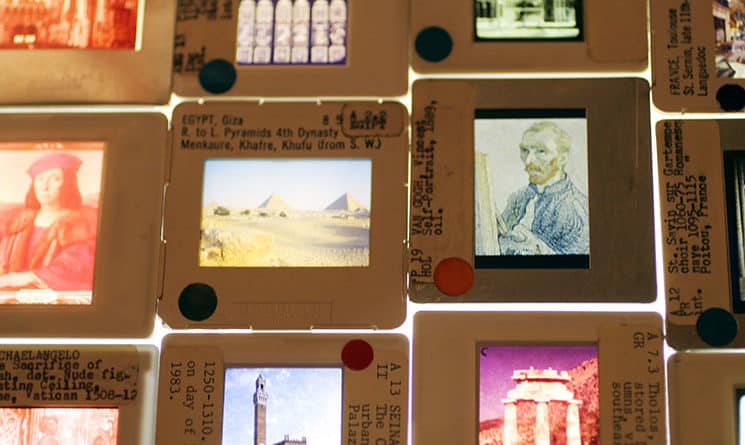Lamont Gallery explores the curious impulse to collect objects
Words and photos by Chloe Kanner
On one wall of the Lamont Gallery, an impressive portrait of George Washington dates back to 1840. On the shelf directly above it sits Michael Jackson’s “Thriller,” a best-selling album since 1982.
Turns out, the first president of the United States and the “King of Pop” have something in common. Memorabilia related to their accomplishments are both sought after by collectors, albeit different collectors.
“Open House: A Portrait of Collecting” explores the impulse to seek out, save, and display objects. It is on view through Feb. 28 at Phillips Exeter Academy’s Lamont Gallery.
The painting of Washington belongs to the American Independence Museum in Exeter, where there is a significant collection of artifacts from the founding of the nation. This includes some oddities, such as a small part of the elm tree under which Washington took command of the American Army, which is also on display. The portrait is painted in the style made famous by Gilbert Stuart, but it’s not known if he painted it, or perhaps Rembrandt Peale.
The “Thriller” record is one of many albums in Jeff Ward’s personal collection. He’s a science instructor at the academy, and simply prefers the way music sounds on vinyl.
The surprising and seemingly unorganized arrangement of the objects is intentional. It is modeled after a “cabinet of curiosity” or “wonder cabinet,” a historical way of filling private homes with strange, beautiful, or otherwise remarkable things, often arranged in unorthodox groupings. The accumulation and display of objects was, and still is, partially about impressing others. But there are many other reasons, and there are often deeper sentiments involved.
Some people collect for economic reasons, hoping their objects will increase in value, often for the perceived benefit of future generations. This seems particularly important to people that struggled to provide for their children during the Great Depression. A few black and white photographs from this time are on display, including a print of Dorothea Lange’s era-defining “Migrant Mother,” part of Dartmouth College’s art collection.
Some collectors seek to maintain a connection with the past, to learn about it and to teach it. Their objects might be priceless and irreplaceable pieces of our shared history, or keepsakes from our individual families. Sometimes the motivation is knowledge, and sometimes, just nostalgia. For Ingrid Bryon, inheriting her grandmother’s button collection was mostly about nostalgia, though in this exhibit, the buttons provide knowledge too.
Ingrid Bryon inherited her grandmother’s buttons.
Other times, collecting comes from curiosity, a study of a trend or style that we either appreciate or don’t fully understand. John Sideli is an antiques dealer who, in recent years, started collecting and selling paint-by-number paintings. These kits were immensely popular in the 1950s, a sign of post-war prosperity and increased leisure time, and the results are generally considered unoriginal and inauthentic. Yet, seeing many of them together brings out the presence of individuals in these paintings.
Paint-by-numbers collected by antiques dealer John Sideli.
From push-puppet toys to pop-art prints, the volume and variety of things we collect is overwhelming, and this exhibit captures that. It takes a couple of hours to take it all in. In one room, there are Classical artifacts from the school’s Latin Studies case, like an ordinary looking stone that was supposedly used in a slingshot some 2,160 years ago. In another room, there are projector slides that were used in Art History classes not long ago.
For Bruce Phillips, of the Radio Orphanage online store, collecting fills a combination of interests. He still owns his first radio, which was given to him at the age of 12, and his appreciation grew with his career as an electrical engineer. The mid-century modern radios in his collection are astounding in the quality of their design, materials and condition. It is clear that their function was important, but they were also a means of expression and a source of pride.
Bruce Phillips’ Fada 100 radio from 1945.
Collecting things that are beautiful and useful can be a business or a passion. It can come from a philosophy of reusing, or an interest in history and the handmade. But, whatever the reason, the fascinating result is that while collecting pieces from history, we’re also gathering tangible memories of our own existence.
Lamont Gallery is located on Phillips Exeter Academy’s campus at 11 Tan Lane, Exeter.

